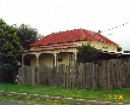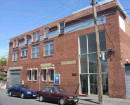CAVE HILL LIMESTONE QUARRY
MELBA AVENUE AND 4 MELBA AVENUE LILYDALE, YARRA RANGES SHIRE
-
Add to tour
You must log in to do that.
-
Share
-
Shortlist place
You must log in to do that.
- Download report



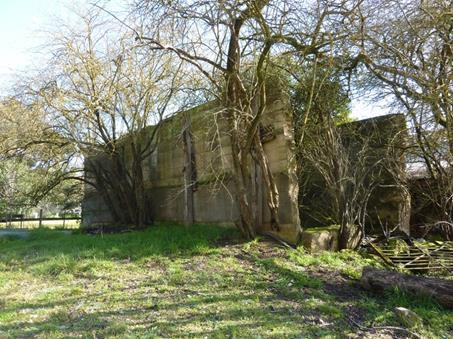
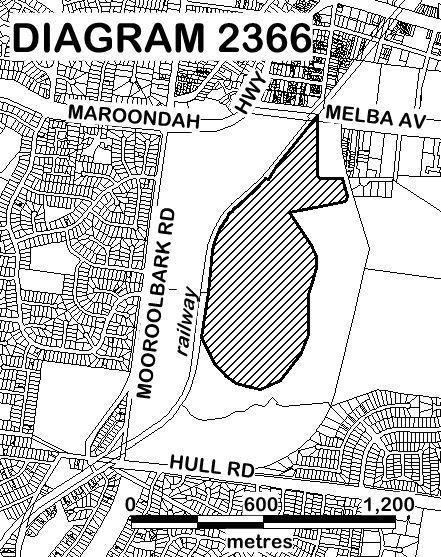
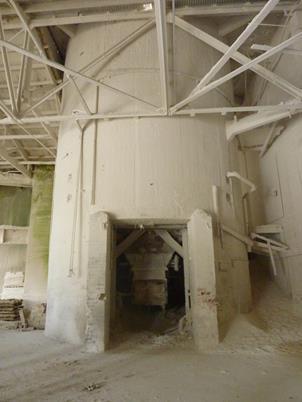



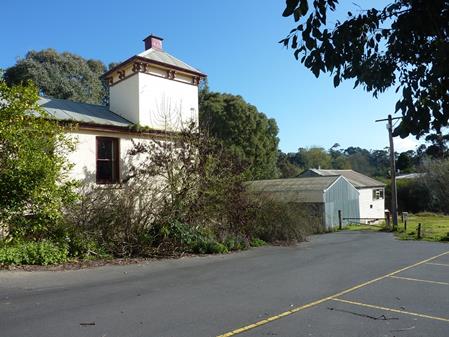
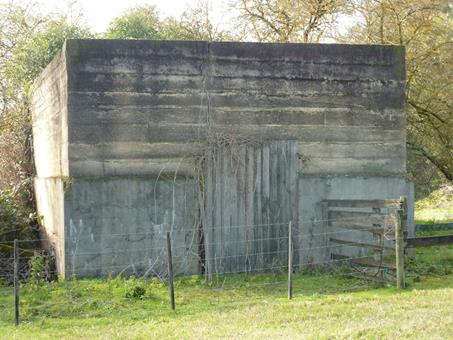
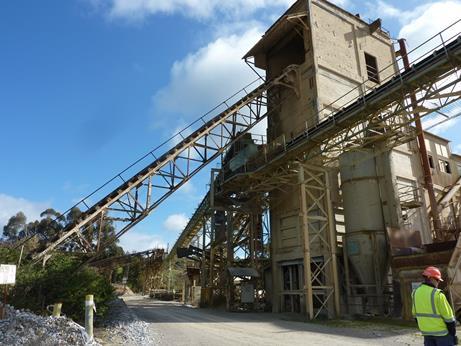
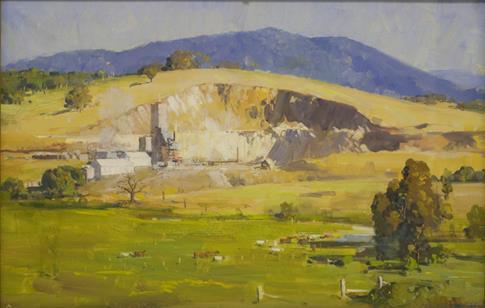
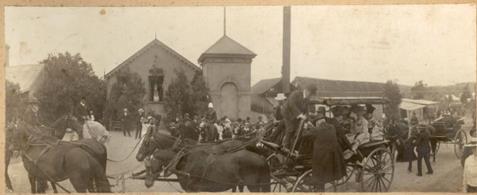

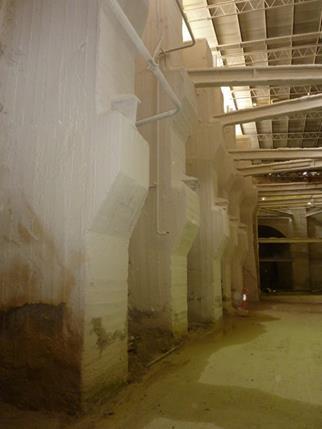
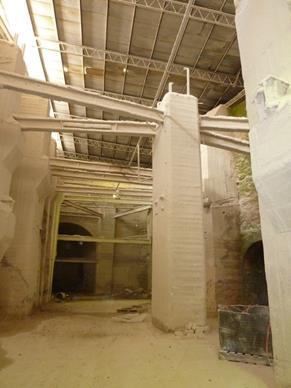
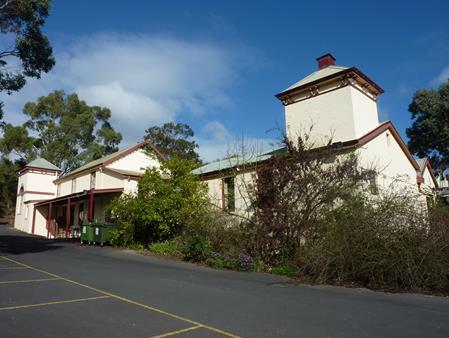
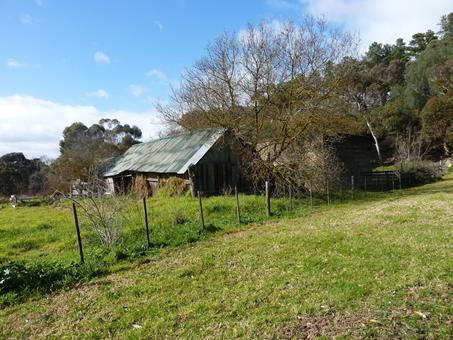

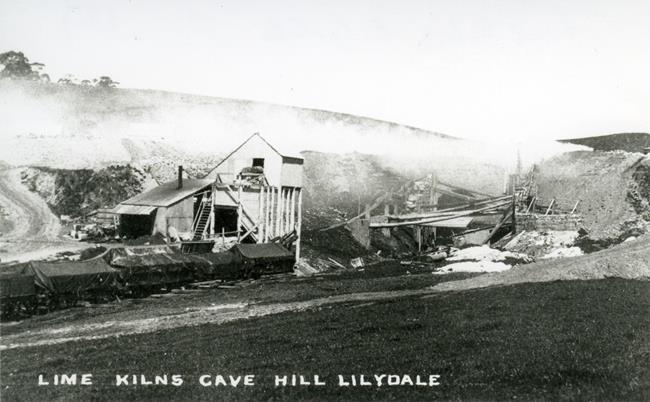
Statement of Significance
Cave Hill Limestone Quarry including the quarry pit, structures and plant for processing limestone and the production of lime-based products dating to the 1880s (tunnel and battery of pot kilns) and 1920s (no. 1 kiln, picking station, incline hoist, road metal plant and riveted steel hopper), rail siding and section of rail platform, remnants of the late-nineteenth century Cave Hill farm, specifically the dairy and bacon factories and silage store; eastern driveway; and memorial gateposts.
History SummaryCave Hill Limestone Quarry is a limestone quarry and processing plant established in 1878 by David Mitchell (1829-1916). Mitchell also established a farm at the site, which operated from the 1880s to c. 1921. Mitchell was a Scottish-born building contractor who became a prominent figure in Victorian society, and was the father of Dame Nellie Melba. Mitchell's building projects included Scots Church (1873-74) and the Royal Exhibition Building (1880). A successful entrepreneur, he was involved in many business ventures including the highly successful Cave Hill Limestone Quarry. During the nineteenth century the production of lime mortars and plasters were integral to construction. Lime production in Victoria started on a small scale in the 1830s, concentrated in coastal locations, notably Geelong. The Cave Hill Limestone Quarry represents the second stage of the lime industry in Victoria, characterised by access to rail transport and management by larger companies. David Mitchell invested in infrastructure such as steam powered cranes, a network of tramlines to transport timber, and a battery of pot kilns that enabled round-the-clock lime burning, despite the limitations of the intermittent technology. The Cave Hill estate also supported a large-scale farming operation. By 1894 dairy and meat-processing 'factories' were established at the site. In 1916, following Mitchell's death, the ownership of Cave Hill passed to the David Mitchell Estate Trust. During the 1920s the plant and equipment continued to be remodelled and mechanised, and Cave Hill Limestone Quarry became one of the leading industrial plants in Australia. In June 1958 the business passed to the David Mitchell Estate Limited. The eastern two-thirds of the property were excised from the quarry site. Much of this land was subdivided into housing estates, and the Lilydale Lake was created. In November 2002, Unimin Australia (now Sibelco) purchased David Mitchell Limited, ending the Mitchell family association. In 2012, the company determined that the quarry would not be viable in the longer term.
Description SummaryThe Cave Hill Limestone Quarry is located approximately 1km south-west of Lilydale town centre. It includes a quarry pit, the limestone processing area and a former mixed farm. The place retains a wide diversity of industrial and farm buildings, plant and elements dating from the late-1870s through to the early and latter twentieth century. The lime processing precinct includes multiple layers of infrastructure and plant dating from the late nineteenth century, and in some cases the operational relationships between significant elements is obscured. Significant topographical change occurred at the site between 1878 and 2015 relating to extraction and processing of lime.
Registered Aboriginal Party (RAP)
Cave Hill Limestone Quarry is located within the traditional language boundaries of the Woi wurrung, who made up one of the seven Kulin Nation language groups. There is no Registered Aboriginal Party (RAP) for the site. The Wurundjeri Tribe Land and Compensation Cultural Heritage Council Incorporated is the current applicant for RAP status for the activity area having lodged application for this on 24 August 2007.
How is it significant?Cave Hill Limestone Quarry is of historical and technical and significance to the State of Victoria. The place satisfies the following criteria for inclusion in the Victorian Heritage Register.
Criterion A
Importance to the course, or pattern, of Victoria's cultural history.
Criterion B
Possession of uncommon, rare or endangered aspects of Victoria's cultural history.
Criterion D
Importance in demonstrating the principal characteristics of a class of cultural places and objects.
Criterion F
Importance in demonstrating a high degree of creative or technical achievement at a particular period.
Criterion H
Special association with the life or works of a person, or group of persons, of importance in Victoria's history.
Why is it significant?Cave Hill Limestone Quarry is significant at the State level for the following reasons:
Cave Hill Limestone Quarry is of historical significance as one of the primary sources of limestone in Victoria from its establishment in 1878 to its closure in 2015. Established by prominent entrepreneur David Mitchell, the place is associated with the second wave of lime burning and extraction technologies in Victoria which flourished as a consequence of the expansion of Victoria's rail network. The place demonstrates three generations of lime processing plant and equipment, broadly dating from the 1880s, 1920s and 1960s. The surviving farm buildings, including the 1890s dairy and bacon factories and the silage store, provide evidence of Mitchell's innovative farming enterprises at Cave Hill, with their emphasis on efficiency and waste minimisation, particularly in relation to dairying. [Criterion A]
Cave Hill Limestone Quarry is rare, being one of a small number of places in Victoria that demonstrates the large-scale production of lime. The tunnel to the north of the quarry pit contains a large and intact battery of pot kilns which enabled the continuous production of lime. This sizable collection of pot kilns is rare. The 1920s phase of plant remodelling included the no. 1 kiln which is one of the earliest continuous mixed-feed vertical shaft kilns in Australia. [Criterion B]
Cave Hill is of significance as a notable and early example of an extant quarry complex in Victoria. It demonstrates the principal characteristics of a place associated with the extraction, processing and transportation of raw minerals. The limestone products from Cave Hill Limestone Quarry made a vital contribution to Victoria's building and construction industry from 1878 to the 1960s. (Criterion D)
Cave Hill Limestone Quarry is of technical significance for use of innovative technologies in lime processing which radically departed from traditional methods. These include the battery of pot kilns (commenced in 1880s) and advances implemented during a major redevelopment in the 1920s to designs by Gilbert McAuliffe Pty Ltd, consulting engineers of Melbourne, with bespoke equipment by Chas Ruwolt Pty Ltd. These include the no. 1 kiln, picking station, incline hoist, road metal plant, riveted steel hopper and conveyor. Cave Hill Limestone Quarry received accolades for its innovations and became recognised as one of the leading industrial plants in Australia. The 1920s upgrade transformed the appearance of the site, introducing the tall structures and elevated conveyors which still distinguish it. Three structures at the site - the Dairy Factory, silage store and concrete retaining walls to the Tunnel - demonstrate the early use of mass concrete. (Criterion F)
Cave Hill Limestone Quarry's association with David Mitchell, one of Victoria's most outstanding nineteenth century entrepreneurs and public figures, is of historical significance. The site provides evidence of Mitchell's diverse and successful business interests, including the development of products for the construction industry, lime extraction and modern farming. Cave Hill Limestone Quarry has a comparatively high level of public recognition as a Mitchell property, more so than many other places with which he was associated during his long and distinguished career. (Criterion H)
In addition to the above, the place may be of significance for the following reasons:
Cave Hill Limestone Quarry is of local historical significance as a place of residence for many quarry workers, particularly during the depression. Many local workers enlisting for World War II listed Cave Hill as their place of address.
The landscape values of Cave Hill Limestone Quarry (including views into and out of the site) are of local significance. The following aspects of the quarry landscape are highly evocative for the local population - the chimneys, rising smoke, machinery noise and movement within the site.
-
-
CAVE HILL LIMESTONE QUARRY - History
CONTEXTUAL HISTORYLimestone, lime mortar and lime products
Limestone is a sedimentary rock composed of calcium carbonate (CaCO3). It is formed from the compressed remains of corals, shells and skeletons, and is found in marine and non-marine environments. The Cave Hill deposit is an example of a marine environment, the land having previously been submerged under the sea. Limestone is typically found in bedding planes between other types of sedimentary rock, including clay and sandstone. This is the case at Cave Hill. Joints between the bedding planes mean that limestone formations are permeable and prone to processes of erosion, both on the surface and below ground. The dissolution of limestone layers means that cave formations are a common characteristic of limestone deposits (karst landscapes).
At Cave Hill, lime was originally processed for use in the construction industry, primarily as an ingredient in lime mortar. This is one of the oldest known types of mortar, dating back to the 4th century BC and widely used in Ancient Rome and Greece. Historically, limestone was extracted, broken down and sorted by hand. Mechanisation introduced from the early years of the twentieth century transformed the process. At its simplest, lime mortar is produced as follows:
Limestone (calcium carbonate CaCO3) is heated to a minimum of812degreescelsius, a process known as calcination. Lime/quicklimecalciumoxide(CaO) is created and takes the form of white lumps. Allcarbondioxideand water is removed during this process. Lime/quicklimeisthenconverted into hydrated/slaked lime, a dry powdercalledcalciumhydroxide (Ca(OH)2), by adding water. Hydrated/slaked limecanthen bemixed with sand (and/or other fine grained aggregate)andsufficientwater to make a lime mortar. When the lime mortar hasbeenlaid, thehydrated/slaked lime in it slowly begins to react withcarbondioxide inthe air to harden and form limestone (calciumcarbonateCaCO3). Thus,the creation of lime mortar is a circular processwhichinvolvesconverting limestone (calcium carbonate CaCO3) backintolimestone(calcium carbonate CaCO3).Lime is a cheap alkaline material which has had multiple applications in the construction industry and in agriculture. It has been used in metallurgy, chemicals manufacture, sanitation, pulp and paper processing, ceramics and the petroleum industries. Other uses have included:
Lime/quicklime can be spread directly on the ground to reduceacidityandimprove soil structure. Lime/quicklime was used for thedisposalofhanged bodies in gaols. Lime wash is hydrated/slaked limeofpaint-likeconsistency, used as a wall covering and can be colouredbythe use ofpigments.The Origins of Cave Hill Limestone Quarry
Lime burning and production activities in Victoria closely followed the arrival of settlers, because of the need for lime for building construction. From 1836 lime burning activities were concentrated on the Mornington Peninsula and at Geelong, often in small local operations such as those at Point Nepean, Sorrento, Rye, Queenscliff and Point Lonsdale. These were located along the coast close to ports and represent the first wave of lime producers in Victoria. The building boom that followed the 1850s Gold Rush increased the demand for lime. Imported lime was expensive, so local entrepreneurs seized on the opportunity to create larger local enterprises. The Melbourne Lime Company was formed in 1860 as a major supplier, and by 1874 this was subsumed under the Melbourne Builders Lime and Cement Company which included among its members David Mitchell. The later nineteenth century also saw the expansion of Victoria's railways which made the inland production of lime viable and cheaper to transport. Cave Hill Limestone Quarry was part of this second wave of lime production in Victoria characterised by larger business enterprises, an increasing use of new technologies and rail access.
Cave Hill Limestone Quarry is situated on land which was originally Crown Allotments 20 and 21 of the Parish of Mooroolbark. These allotments, along with the adjacent allotment 26, were acquired from the Crown by William Nicholson on 13 December 1855. Nicholson was a prosperous merchant and land owner and a member of both the Legislative Council and Legislative Assembly in the Victorian parliament during the 1850s and 1860s. He held the position of Premier briefly in 1855 and again in 1859-1860, and died in March 1865. Nicholson's three allotments comprised approximately 514 hectares (1,270 acres). Nicholson's property was known as Cave Hill Farm as early as 1864, a reference to the prominent escarpment and the numerous caves within it. It was leased to Allan Fisher and James Cashin for a period of 20 years from 1861. Cave Hill Farm appears to have operated as a mixed use farm run by Fisher, with a notice published in the Argus in 1864 reporting the sale of 'horses, cows, farming and dairy utensils, pigs, hay, potatoes'. In 1871 and 1875, notices were published in the Argus advertising lease of the farm.
Between 1853 and 1869 the Government geological surveyor, Alfred Selwyn undertook the Geological Survey of Victoria, concluding his survey of the district east and north of Melbourne in 1856. Selwyn identified Cave Hill as having the 'only limestone beds in the entire area,' although the limestone was not visible from the surface. An 1856 plan of the Parish of Yering, immediately to the north of the Parish of Mooroolbark, noted a 'Cave - 130 feet deep', in the approximate location of the quarry. It has been suggested that the cave was used for recreational purposes. Though there is little documentary evidence to corroborate this, it appears likely it was used for such purposes. Reminiscences of 'old Lillydale' published in local newspapers in the interwar period did refer to the cave as a local attraction in this early period, with groups being windlassed down the cave.
Cave Hill Limestone Quarry is located in Lilydale, which was originally part of the parishes of Yering and Mooroolbark. Crown land sales of allotments in Yering began in 1852 and in Mooroolbark in 1855. Early uses of the land included cattle grazing and timber felling. The population of the district remained sparse into the 1850s, with only 40 people recorded in Mooroolbark and 179 in Yering in 1854. The township of Lilydale (originally known as Lillydale) was surveyed in 1859, and the first land sale of town lots was held the following year. Lilydale was the largest of the early farming townships in the Yarra Ranges district. By 1862 the town had a small number of stores and a hotel. With the discovery of gold at Wood's Point north-east of Melbourne in the early 1860s, Lilydale became an important stop for traffic on the way to the goldfields, and a number of new businesses were opened up catering for the increased population. By the 1870s, agriculture in the area had diversified to include dairying, fruit growing and viticulture. The opening of the railway line from Hawthorn to Lilydale in 1882 was the next catalyst for further development in the township. The rail link to Melbourne was a boon for local businesses, bringing tourists and day-trippers in 'search of health and pleasure', and enabling local products to be quickly and more cheaply transported to the city markets.
David Mitchell's Acquisition of Cave Hill
David Mitchell officially acquired the 'freehold estate known as Cave Hill Farm' from the estate of William Nicholson on 1 May 1878 for £8000. The property comprised the 1,280 acres (518 hectares) of allotments 20, 21 and 26. At the same time, Mitchell leased an additional 320 acres (130 hectares) from a Mr Twentyman, which included the site of Cashin's Mill on Olinda Creek. Mitchell had leased property in the district from as early as 1868, and in 1875, became a councillor of the Shire of Lilydale, serving until 1883. He was voted president of the Shire of Lilydale in March 1883, after having served as vice president the previous year. As part of this acquisition, an early termination of the leases on the land was agreed to. Interestingly, the net annual value of the property, as recorded in the rate books, did not increase substantially after the establishment of the quarry, being £310 in 1878 and £365 in 1881. After the construction of the railway, and the resultant increase in production and higher land values in Lilydale, the net annual value of the property increased to £600 in 1885 and to £1,016 in 1892.
David Mitchell was born on 16 February 1829 in Forfarshire, Scotland and after completing an apprenticeship to master mason, James Watson, Mitchell sailed to Melbourne in 1852. He established himself as a building contractor and built a shanty on land in Richmond. With business in Melbourne poor due to the gold rush, he travelled to Sandhurst (Bendigo), but returned to Richmond the following year. In 1856 he tendered successfully for the masonry work for St Patrick's Cathedral, Eastern Hill, and in the same year he married Isabella, daughter of James Dow. They lived at Doonside, a self-built house at Mitchell's premises on Burnley Street, Richmond. The couple had ten children, including Helen Porter Mitchell (Dame Nellie Melba), who was born at Richmond on 19 May 1861.
From the 1860s to the end of the nineteenth century, David Mitchell was one of Victoria's leading building contractors. The Menzies Hotel on William Street (completed 1857); the Paterson, Laing & Bruce warehouse, Flinders Lane (1871); Scots Church, Collins Street (1874, VHR H0005); the Royal Exhibition Building (1880, VHR H1501); the Masonic Hall, Collins Street (1888); and the Equitable Insurance Building (1893) were among the more prestigious of the many Melbourne buildings completed by his company during this period. By the late 1870s, he was a prominent and well-known member of the Melbourne community. In the late-1860s, Mitchell had acquired property at Steel's Flats, between Lilydale and Healesville. Mitchell later became a councillor of the Shire of Lilydale, serving from 1875 until 1883. During this period he also acquired the Colbinabbin Station near Rushworth (VHR H1730) and properties near Camperdown (Jancourt) and Mansfield (Dueran).
As well as his career as a contractor, Mitchell had a range of other business and property interests. In 1859, he established a factory for steam-made and pressed bricks at his Richmond works. He became a partner in the Darley Firebrick works at Bacchus Marsh in 1898, and the major shareholder in 1902. In 1890 Mitchell commenced production of plaster ('Adamant') and Portland cement at his Burnley works, using materials from Cave Hill, and in the late 1890s he went into business with engineer John Monash. Since 1894 Monash had been in the engineering and patent agents partnership Monash & Anderson, who went on to pioneering the use of reinforced concrete in Victoria. After the firm Monash & Anderson suffered financially as the result of a lengthy legal battle, David Mitchell offered financial support by providing capital to establish the Monier Pipe Co Ltd of Victoria (established 1901) and also offered land for the venture next to his Burnley cement works on condition that his products were used. This arrangement was beneficial for both parties: by 1913 Monash was worth over £30,000, and Mitchell benefitted from linking his Richmond cement factory and the neighbouring reinforced concrete pipe factory.
During the 1870s David Mitchell became a founding member and shareholder of the Melbourne Builders' Lime and Cement Company (MBLCC), which aimed to break the monopoly of the Geelong and Peninsula lime producers. MBLCC was associated with the second wave of lime production in Victoria, characterised by industrial-scale production replacing small-scale owner-operators. In 1886, as the Commissioner for Australia to the Indian and Colonial Exhibition, Mitchell travelled to London. He retired from the building contracting business in 1899, from which point he concentrated on other interests. Although he spent much time in Lilydale, his primary residence was in Richmond. In later years, Mitchell's individual achievements were somewhat eclipsed by the celebrity status of his daughter, opera singer Dame Nellie Melba; from the early twentieth century, newspaper reports would often refer to him as 'the father of Madame Melba'. David Mitchell died in March 1916, aged 87. He had been actively involved in the running of Cave Hill until only a few days before his death.
HISTORY OF THE PLACE
Development of Cave Hill Limestone Quarry
The quarries at Cave Hill opened on 2 April 1878. Challenges confronting David Mitchell included 1) how to burn lime at a site without natural cliff faces; 2) how to optimise the lime resource with the limitations of contemporary burning technologies (pot kilns); and 3) how to transport the products off-site in the absence of a rail line. From the 1880s, Mitchell cut directly into the north end of the limestone creating hillsides into which pot kilns could be constructed. The length of the cutting enabled multiple kilns to be constructed. By 1882 the quarry was producing 1,000 bags per week, and in 1887, there were 70 men working at the quarry, with kilns operating 'night and day' during the week and two steam cranes soon to be installed. Mitchell further expanded his operations, replacing the 'slow and expensive' horses and drays used to transport the limestone from the quarry to the kiln, with a system of water wheels and pulleys. By 1888 five kilns were recorded at Cave Hill and lime output increased dramatically. An 1880s site plan shows a two miles long horse-drawn tramway at the north end of the cutting, to transport timber into the site for the lime kilns. Tram lines were a major feature of the site until the later decades of the twentieth century. The extent of the Cave Hill lime workings can be seen below in a pre-1900s photograph showing the quarry, rail siding tunnel, kilns and associated structures.
At this time, lime was transported to Melbourne by a team of 60 horses. In November 1878 - the same year that Mitchell purchased Cave Hill - the government passed the Railway Construction Bill which confirmed a new rail route from Hawthorn to Lilydale. It appears likely that, due to his considerable influence and standing in the district at this time, Mitchell was able to influence both the route of the line and the subsequent construction of a railway siding to his quarry. A c.1880 plan of the alignment of the railway shows the line originally extending around the east side of Cave Hill. The line was subsequently redrawn around the west of the quarry, with a siding at the north, a route more suited to Mitchell's requirements. This siding was under construction by April 1882, and the railway line itself was opened in December 1882.
By 1887 a homestead had been constructed for an onsite manager of the quarrying and farming operations (demolished in the 1960s). Such was Mitchell's confidence in the commercial potential of Cave Hill, he is believed to have considered forming Cave Hill into a public company from as early as 1888 (but this did not occur until after his death). With improvements in the production of Portland cement throughout the nineteenth century, cement had begun to replace lime mortar as the most common construction material by the 1880s. In response, Mitchell began selling his Emu brand of cement from Cave Hill in 1891, described in one editorial as 'equal to the best Portland [cement]'.
In the early twentieth century, Mitchell expanded his landholding, and constructed what became an extensive network of tramway or light rail lines, to transport the timber from land east of the site to the quarry. At its most extensive, approximately 16 kilometres of tram line had been constructed as part of the network. The tramway ran east from the quarry to Olinda Creek, and then south and east towards the present day Silvan Reservoir. In 1903, Mitchell purchased two redundant steam tram engines from the Bendigo Tramways. The tramway operated until 1934, when the transport of timber by much improved local roads had become viable. During the 1890s steam was used to power much of the site in the quarries, the ice-making, the milking, the butter and cheese making and in cleansing the works. Mitchell constructed a water race from the Olinda Creek, two miles from the quarry. This water was returned to the creek through a brick and cement tunnel, and also supplied the managers' residence and farming operations. In 1892, the Shire of Lillydale rated the Cave Hill Quarry at the significant net annual value of £1,016.
In the 1920s, the Estate undertook a significant program of works to upgrade the machinery and plant at the quarry. Lime hydration was facilitated by a new hydration plant in the mid-1920s (which was replaced in the 1960s). This era saw the production of one of the most enduring products from Cave Hill 'Limil', a hydrated lime with a breadth of building, garden and agricultural applications. Cave Hill also became well known for its toppings ('Lilydale toppings'), which are a limestone by-product. Lime of insufficient purity was also use by Cave Hill to produce aggregates for road building. The David Mitchell Estate Ltd also worked with the Department of Agriculture to develop products that could assist primary producers in countering Victoria's highly acidic soils.
Farming operations
As well as a profitable quarry, the Cave Hill estate supported a large scale farming operation, which commenced in the mid-1880s. Dairying operations commenced at Cave Hill in 1885, with particular emphasis being given to David Mitchell's herd of pure bred Holstein (Fresian) cattle, well suited to high quality dairy products. In 1888 the dairy operated the colony's first mechanical milking device. Mitchell diversified the farming operations to develop butter and bacon in the early 1890s. This may have been a response to the economic depression of the 1890s which had a significant impact on the construction industry. From 1891, Mitchell began to explore the prospect of establishing a butter factory at Cave Hill. Canvassing local dairy farmers at public meetings held in Lilydale and Yarra Glen, Mitchell sought to guarantee supply from local farmers, who appear to have been willing to change their associations away from the Melbourne buyers. The site for the new butter factory, to the east of the homestead, was decided in November 1891. During the 1890s factory supplied local butter markets and Cave Hill butter was also shipped to London for sale in England.
From early 1893, cheese production commenced at Cave Hill, and was quickly established as a profitable enterprise. The Cave Hill Mitchell dairy was the first farm utilised by the Pure Milk and Dairy Company Ltd for the production of pasteurised milk in Victoria. Mitchell, 'placed his refrigerating plant and premises at [the company's] disposal for experiments,' and the treatment of the milk 'by the best approved scientific method, free from chemicals' was deemed a resounding success by witnesses of the medical profession, veterinary experts and scientists in December 1897. The production of pasteurised milk saw the suspension of cheese making, which was resumed in 1898 after the demand for the Pure Milk and Dairy company's products became too great for the Cave Hill facilities. In 1893 Mitchell constructed a bacon factory building to the north of the butter factory. It comprised a 'cutting down room', which was provided with a 'patent floor of cement and granite chips', and a double-storey smoking room with a tower 40 feet tall, and a cooling room and drying room. Each room of the factory could process hundreds of sides of bacon at a time. In adjacent buildings in the farm complex, sheep and cattle were killed to supply local butchers, and animal bones were steamed and ground to produce soil fertiliser. The products of the factory were sold in butcher shops across Melbourne, and interstate. Bacon continued to be produced into the early part of the twentieth century.
By the early 1900s, the farm complex had expanded eastwards. A 1907 panoramic photograph of the Cave Hill Estate indicates a densely developed collection of buildings around the butter and bacon factories. A soap and candle factory was also established at the property in c.1900. The Cave Hill farming operations were of a scale not common in the area, and the associated buildings were of a picturesque style atypical for agricultural buildings. The farming operations demonstrate Mitchell's emphasis on efficient and economic industrial production, and avoidance of waste. The leftovers from the butchering were in turn boiled down and the fat used in soap. Following Mitchell's death in 1916, the dairy and bacon operations had ceased operation by c.1921.
In the early twentieth century, employment at the estate peaked, at approximately 200, when the farming factories were fully operational, as well as the quarry. In the mid-1930s, Cave Hill management established the Cave Hill Social Club. A cricket oval was established by 1936 on land now situated between the two entrance drives, with the club hosting (and winning) matches in their debut season. Management also temporarily made available a 'large room', in which the workers 'spent many happy hours at billiards, cards and harmony'. After World War Two at the entrance to the second roadway, memorial gates were erected with honour boards on each pillar acknowledging the Cave Hill workers who had fought in the war. The memorial gates were officially opened by Mrs C J Mitchell, on 16 November 1947.
Dame Nellie Melba
The most high-profile social event at the quarry was the triumphant return by David Mitchell's daughter Dame Nellie Melba to Australia, and to her childhood home of Lilydale, in 1902. Melba had left Melbourne for Paris in 1886, and after years spent in Europe and North America, her singing career had made her an international celebrity. Melba had 'kindly consented' to a request by the estate's employees to welcome her to Cave Hill. An arch was erected at the entrance of the estate, which was decorated with flags and the words 'Dame', 'Melba' and 'Employees Greet You'. The 'spacious enclosure' surrounding the residence of her brother, Charlie, was turned into a foliaged private park, and a platform erected for the reception of Melba. After an address by quarry manager Fuller, expressing 'deep feelings of pride and pleasurable satisfaction at being permitted the honour of welcoming the 'gifted daughter' of Lilydale, David Mitchell spoke on her behalf. He noted that she appreciated the affection and kindness of those attending, and explained that she had taken a 'deep interest' in the welfare of the employees of Cave Hill.
After David Mitchell's Death
David Mitchell died in 1916, and ownership of Cave Hill and the Burnley cement works passed to his seven children Francis, Charles, Ernest, Helen (Nellie), Ann, Isabella and Dora as tenants in common, with Francis and Edward Albert Newbigin as trustees. Cave Hill formed a significant part of Mitchell's estate, which also included landholdings in the parishes of Mooroolbark, Yering, Gruyere, Jika Jika with a capital value of £123,678. In 1919, the trustees sold 450 acres of the Cave Hill estate, which had been subdivided into 64 allotments. This significantly reduced the landholding. Further trustees' realising auctions were held in the mid-1920s for land to the south and east of the quarry, again reducing the landholding.
In 1948, the new State highway between Camberwell and Mansfield, to be known as the Maroondah Highway, was declared. At this time, reliance on rail for the main transportation of quarry products began to give way to road transport, possibly due to improvements made to the highway. It was in this period that access to the site also changed, and the twin entranceways were established, providing more direct road access between the quarry and the highway. As can be seen on a c.1940s plan of Cave Hill, by this time many of the farm buildings had been removed, and an overburden dump was situated to the north of the quarry. By 1952, a caretaker's residence had been constructed and by 1972 the homestead had been demolished.
In 1958, after the death of the last of David Mitchell's children, the trustee company was no longer bound by David Mitchell's will. In June 1958, a circular was distributed to the estate's business contacts announcing that from 1 July the newly formed 'David Mitchell Estate Limited' company would be operational. In October 1958, the eastern two-thirds of the property were excised from the quarry site, giving the southern part of the property its curved boundary. Much of this land was subdivided into housing estates, and the Lillydale Lake was created on land which was formerly part of William Nicholson's Crown allotment 26. In 1959, a survey was undertaken which concluded there was sufficient lime for another 140 years at the present rate of production. The report noted that another 70 years supply also existed on the western side of the railway line. It was decided to invest in new quarry crushing and conveying equipment and approximately £130,000 was spent on new machinery between 1959 and 1962. In 1976, all three kilns were converted from oil to natural gas, and in 1977, a larger crusher was installed at the top of the quarry replacing the earlier crusher on the west face.
In November 2002, Unimin Australia purchased David Mitchell Limited, 'the nation's leading independent producer of limestone products', ending the Mitchell family association with the Cave Hill quarry site, after nearly 125 years. The Unimin group of companies was based in the United States, controlled by SCR Sibelco, a company started in Belgium in 1872. The company established operations in Australia in 2000, and in 2011, the company changed its name to Sibelco. In 2012, the company determined that the quarry would not be viable in the longer term. Sibelco and the Victorian Government urban renewal authority, Places Victoria, entered into an agreement to master plan the future development of the site.
Artistic representations of Cave Hill
The striking landscape of Cave Hill quarry has been the subject of paintings and artistic representations from as early as 1889, and continuing into the late twentieth century. The scenic qualities of the lime processing complex sited within a pastoral landscape, appears to have been a popular artistic subject. Artists including Arthur Streeton, John Perceval and Fred Williams painted from a vantage point to the north, setting the buildings against the quarry face and the hills behind.
Known examples of paintings of Cave Hill include:
A Victorian Dale, James Alfred Turner, c. 1889; The Lime Kiln (also known as Mitchell's Lime Quarry), Arthur Streeton, 1935; View of Cave Hill, James Peter Quinn, c. late 1930s; The Quarry, Lilydale, Ernest Buckmaster, undated; Lilydale Lime Quarry, Ivy Burton Fox, c. late 1950s, Fox also depicted the site in two ink drawings; Lime Quarry, Lilydale, John Perceval, 1956; Lilydale Landscape with Blue Train, Fred Williams, 1974, Williams also depicted Cave Hill in Lilydale Triptych I, 1974 and Lilydale Triptych II: Cave Hill, 1974; Cave Hill, Jennifer Paull, 1985; Butter and Bacon Factories and Cave Hill Quarry, Dora Wilson, undated.
Key references
Lovell Chen, 'Cave Hill Quarry, Melba Avenue, Lilydale Conservation Management Plan', 2015
Jane Harrington, 'The Lime-Burning Industry In Victoria: An Occupance Approach', Australasian Historical Archaeology, 14, 1996, pp. 19-24. Jane Harrington, An Archaeological and Historical Overview of Limeburning in Victoria, Heritage Council of Victoria, 2000.CAVE HILL LIMESTONE QUARRY - Plaque Citation
The Cave Hill Limestone Quarry was established in 1878 by David Mitchell, one of Victoria's most prominent nineteenth century entrepreneurs. Demonstrating three generations of lime processing, it was known for its use of innovative technologies and was recognised as one of the leading industrial plants of its time in Australia.
CAVE HILL LIMESTONE QUARRY - Assessment Against Criteria
Criterion
Cave Hill Limestone Quarry is significant at the State level for the following reasons:
Cave Hill Limestone Quarry is of historical significance as one of the primary sources of limestone in Victoria from its establishment in 1878 to its closure in 2015. Established by prominent entrepreneur David Mitchell, the place is associated with the second wave of lime burning and extraction technologies in Victoria which flourished as a consequence of the expansion of Victoria's rail network. The place demonstrates three generations of lime processing plant and equipment, broadly dating from the 1880s, 1920s and 1960s. The surviving farm buildings, including the 1890s dairy and bacon factories and the silage store, provide evidence of Mitchell's innovative farming enterprises at Cave Hill, with their emphasis on efficiency and waste minimisation, particularly in relation to dairying. [
Criterion A]
Cave Hill Limestone Quarry is rare, being one of a small number of places in Victoria that demonstrates the large-scale production of lime. The tunnel to the north of the quarry pit contains a large and intact battery of pot kilns which enabled the continuous production of lime. This sizable collection of pot kilns is rare. The 1920s phase of plant remodelling included the no. 1 kiln which is one of the earliest continuous mixed-feed vertical shaft kilns in Australia. [
Criterion B]
Cave Hill is of significance as a notable and early example of an extant quarry complex in Victoria. It demonstrates the principal characteristics of a place associated with the extraction, processing and transportation of raw minerals. The limestone products from Cave Hill Limestone Quarry made a vital contribution to Victoria's building and construction industry from 1878 to the 1960s. (
Criterion D)
Cave Hill Limestone Quarry is of technical significance for use of innovative technologies in lime processing which radically departed from traditional methods. These include the battery of pot kilns (commenced in 1880s) and advances implemented during a major redevelopment in the 1920s to designs by Gilbert McAuliffe Pty Ltd, consulting engineers of Melbourne, with bespoke equipment by Chas Ruwolt Pty Ltd. These include the no. 1 kiln, picking station, incline hoist, road metal plant, riveted steel hopper and conveyor. Cave Hill Limestone Quarry received accolades for its innovations and became recognised as one of the leading industrial plants in Australia. The 1920s upgrade transformed the appearance of the site, introducing the tall structures and elevated conveyors which still distinguish it. Three structures at the site - the Dairy Factory, silage store and concrete retaining walls to the Tunnel - demonstrate the early use of mass concrete. (
Criterion F)
Cave Hill Limestone Quarry's association with David Mitchell, one of Victoria's most outstanding nineteenth century entrepreneurs and public figures, is of historical significance. The site provides evidence of Mitchell's diverse and successful business interests, including the development of products for the construction industry, lime extraction and modern farming. Cave Hill Limestone Quarry has a comparatively high level of public recognition as a Mitchell property, more so than many other places with which he was associated during his long and distinguished career. (
Criterion H)
In addition to the above, the place may be of significance for the following reasons:
Cave Hill Limestone Quarry is of local historical significance as a place of residence for many quarry workers, particularly during the depression. Many local workers enlisting for World War II listed Cave Hill as their place of address.
The landscape values of Cave Hill Limestone Quarry (including views into and out of the site) are of local significance. The following aspects of the quarry landscape are highly evocative for the local population - the chimneys, rising smoke, machinery noise and movement within the site.
CAVE HILL LIMESTONE QUARRY - Permit Exemptions
General Exemptions:General exemptions apply to all places and objects included in the Victorian Heritage Register (VHR). General exemptions have been designed to allow everyday activities, maintenance and changes to your property, which don’t harm its cultural heritage significance, to proceed without the need to obtain approvals under the Heritage Act 2017.Places of worship: In some circumstances, you can alter a place of worship to accommodate religious practices without a permit, but you must notify the Executive Director of Heritage Victoria before you start the works or activities at least 20 business days before the works or activities are to commence.Subdivision/consolidation: Permit exemptions exist for some subdivisions and consolidations. If the subdivision or consolidation is in accordance with a planning permit granted under Part 4 of the Planning and Environment Act 1987 and the application for the planning permit was referred to the Executive Director of Heritage Victoria as a determining referral authority, a permit is not required.Specific exemptions may also apply to your registered place or object. If applicable, these are listed below. Specific exemptions are tailored to the conservation and management needs of an individual registered place or object and set out works and activities that are exempt from the requirements of a permit. Specific exemptions prevail if they conflict with general exemptions. Find out more about heritage permit exemptions here.Specific Exemptions:It should be noted that Permit Exemptions can be granted at the time of registration (under s.42(4) of the Heritage Act). Permit Exemptions can also be applied for and granted after registration (under s.66).
General Condition 1
All exempted alterations are to be planned and carried out in a manner which prevents damage to the fabric of the registered place or object.
General Condition 2
Should it become apparent during further inspection or the carrying out of works that original or previously hidden or inaccessible details of the place or object are revealed which relate to the significance of the place or object, then the exemption covering such works shall cease and Heritage Victoria shall be notified as soon as possible.
General Condition 3
All works should be informed by Conservation Management Plans prepared for the place. The Executive Director is not bound by any Conservation Management Plan, and permits still must be obtained for works suggested in any Conservation Management Plan.
General Condition 4
Nothing in this determination prevents the Heritage Council from amending or rescinding all or any of the permit exemptions.
General Condition 5
Nothing in this determination exempts owners or their agents from the responsibility to seek relevant planning or building permits from the relevant responsible authority, where applicable.
Specific Permit Exemptions
Public safety and security. All works (including the erection of temporary security fencing, scaffolding, hoardings or surveillance systems) to prevent unauthorised access and/or secure public safety which are not fixed to elements of primary and contributory significance.
Removal of lime residue. Removal of lime residue from all buildings and elements by non-destructive means.
Maintenance. All works required to maintain and repair buildings and elements, including rectifying damage by people and animals.
Demolition of buildings and features of low/no significance. Removal of buildings and elements that are not identified as being of primary or contributory significance.
Landscape. All works to vegetation, except to the Desert Ash and Poplar species on the east entry driveway, and the mixed plantation on the west driveway, including a mature Monterey cypress at its northern end.
CAVE HILL LIMESTONE QUARRY - Permit Exemption Policy
Preamble
The purpose of the Permit Policy is to assist when considering or making decisions regarding works to a registered place. It is recommended that any proposed works be discussed with an officer of Heritage Victoria prior to making a permit application. Discussing proposed works will assist in answering questions the owner may have and aid any decisions regarding works to the place.
The extent of registration of Cave Hill Limestone Quarry in the Victorian Heritage Register affects the whole place shown on Diagram 2366 including the land, all buildings (exteriors and interiors), roads, trees, landscape elements and other features. Under the Heritage Act 1995 a person must not remove or demolish, damage or despoil, develop or alter or excavate, relocate or disturb the position of any part of a registered place or object without approval. It is acknowledged, however, that alterations and other works may be required to keep places and objects in good repair and adapt them for use into the future.
If a person wishes to undertake works or activities in relation to a registered place or registered object, they must apply to the Executive Director, Heritage Victoria for a permit. The purpose of a permit is to enable appropriate change to a place and to effectively manage adverse impacts on the cultural heritage significance of a place as a consequence of change. If an owner is uncertain whether a heritage permit is required, it is recommended that Heritage Victoria be contacted.
Permits are required for anything which alters the place or object, unless a permit exemption is granted. Permit exemptions usually cover routine maintenance and upkeep issues faced by owners as well as minor works or works to the elements of the place or object that are not significant. They may include appropriate works that are specified in a conservation management plan. Permit exemptions can be granted at the time of registration (under s.42 of the Heritage Act) or after registration (under s.66 of the Heritage Act). It should be noted that the addition of new buildings to the registered place, as well as alterations to the interior and exterior of existing buildings requires a permit, unless a specific permit exemption is granted.
Conservation management plans
In 2015 Lovell Chen prepared 'Cave Hill Quarry, Melba Avenue, Lilydale Conservation Management Plan'. This should be used to guide the management of the place.
Aboriginal cultural heritage
If any Aboriginal cultural heritage is discovered or exposed at any time it is necessary to immediately contact Aboriginal Victoria to ascertain requirements under the Aboriginal Heritage Act 2006.
Other approvals
Please be aware that approval from other authorities (such as local government) may be required to undertake works.
Archaeology
Ground disturbance may affect archaeological deposits at the place and, subject to the exemptions stated in this document, requires a permit.
Cultural heritage significance - Overview
The cultural heritage significance of Cave Hill Limestone Quarry lies in its demonstration of the principle characteristics of a place associated with the extraction and processing of raw minerals, in this case limestone. Evidence of three generations of lime processing plant survives at the site, including the most extensive known battery of nineteenth century pot kilns in Victoria. During the early twentieth century Cave Hill Limestone Quarry was recognised as one of the leading and innovative industrial plants in Australia. Cave Hill Limestone Quarry is significant for its association with David Mitchell, one of Victoria's most outstanding nineteenth century entrepreneurs. The place also demonstrates many agricultural innovations.
The following buildings, elements and areas are of primary significance in the context of the place. A permit is required for most works or alterations. See Permit Exemptions section for specific permit exempt activities:
. The quarry pit (1878-2015)
. Eastern driveway (c. 1870s) including the Desert Ash and Poplar species at the entry
. The tunnel and battery of pot kilns (c. 1878 - interwar period)
. Disused pot kiln to the south of the Tunnel (1880s)
. Rail siding (1882), rail line and section of rail platform (undated)
. Dairy and Bacon factories (1890s)
. Silage store (1890s)
. No. 1 Kiln (1920s)
. Picking Station (1925)
. Incline hoist (1925)
. Road Metal Plant (1925) including the enclosed conveyor and shaker table
. Riveted steel hopper (1925)
. Memorial gateposts (1947)
The following buildings, elements and areas that are of contributory significance in the context of the place. A permit is required for most works or alterations. See Permit Exemptions section for specific permit exempt activities:
. Timber buildings within the farm precinct, including the 'milking shed' (late 19th century)
. Pedestrian walkway linking the upper and lower sections of the lime processing precinct (undated)
. Sports oval (c. 1930s)
. Western driveway (1940s) including the mixed plantation on the west driveway, including a mature Monterey cypress at its northern end
. The hydration plant (1925 and 1960s)
. No. 2, 3 and 4 kilns (1960s)
. Caretaker's residence (1950s)
. Pavilion (1970s)
The following buildings, elements and areas are not of cultural heritage significance in the context of the place. Specific permit exemptions are provided for these items:
. Buildings and elements introduced in the later decades of the twentieth century, including: the office complex, stores, silos and workshops in the lime processing precinct
. Elevated conveyors, with the exception of the conveyor connecting the Picking Station and the Road Metal Plant
. The primary crusher, relocated to the site from the Snowy River Scheme in the 1970s
. Vegetation (other than the Desert Ash and Poplar species at the entry of the Eastern Driveway and the mixed plantation on the west driveway, including a mature Monterey cypress at its northern end).
-
-
-
-
-
MELBOURNE ROAD WELL SITE
 Victorian Heritage Inventory
Victorian Heritage Inventory -
Old Cave Hill Butter; Cheese & Bacon Curing Factory; David Mitchell Estate
 Yarra Ranges Shire
Yarra Ranges Shire -
The Briars
 Yarra Ranges Shire
Yarra Ranges Shire
-
177 Fenwick Street
 Yarra City
Yarra City -
19 Cambridge Street
 Yarra City
Yarra City -
2 Derby Street
 Yarra City
Yarra City
-
-







